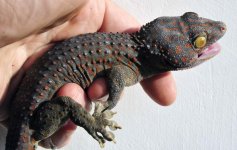So far, all of my back breeding, or line breeding back to the parent has produced one or more visual Tokay morphs.
In a broad sense, not all visual genetics are simple recessive like the Patternless trait in Tokay. And we are only a couple of years into line breeding Tokay, using the same known genetic line, generation after generation.
So my first response is not all visuals, when breed to another visual, will produce all visuals because (A), the visual gene in not simple recessive, and/or (B), the genetic marker in one animal is in a different location on the DNA strand from the location in the second animal. If the markers do not line up in the DNA pairing, you get double het's. Offspring that carry two visual genes, for the same type like albino, but in two different locations on the DNA strand, look normal.
This is true for the three different albino in Leopard Gecko. Bell's must be breed with Bells, and Tremper's with Tremper's to get each version of albino even though they look very much the same at first glance. These differences can be blamed on the separation of locale between each of the different groups that independently developed the albino mutation. (OH, and there's about a dozen different ways to 'create' the albino mutation but I'll keep it simple for this discussion.)
Tokay come from all over South East and Indo China. Most of what we see in morphs come from the Indonesian Islands of which there are over 17,000. That's a lot of locales separated by water and the possibility of a lot of genetically different morphs.
We don't know what most of the traits are. Dominant, Co-dominant, Recessive, Progressive, etc. Until we do, we will be producing lots of possible hets.
My second response is about the lack of time spent. Not too many breeders are past their second generation. I will not have breedable F-2's until late this year or next year. Leopard Gecko are almost 40 generations deep as a comparison.
Third. Unlike most other wild caught single gene reptile morphs that have been discovered and line bred to establish visuals, Tokay tend to be multi-gene in the wild. So one has to work backwards to isolate each visual trait. Have you ever done Punnett Squares with both animals being visual for 2 or 3 genes. For any single combination you can have a 1 in 32 chance, or a 1 in 64 chance of hitting that trait.
Tokay generally don't produce more that 6 to 8 offspring a year for about 4 to 5 years and then start tapering off. In that females viable production lifetime you will NEVER hit the odds of producing every combination that pair might be capable of.
Now here's the kicker. Unlike Ball Python where all these single genes have been combined over several years and rigorously documented, we have no idea what's in the wild multi-gene Tokay. Snakes can produce for 20 years or more making it easier to hit all the combinations over time.
Tokay genetics present a monumental task, many years in the making. A mystery and a challenge most folks don't have the patience for. If you want predictable results, breed Balls, if you want to be a small contributor to a lifelong project, jump and get bit.
The answer to your questions is a simple understanding of genetics, how to use Punnett Squares and the amount of time and generations of breeding required to prove visuals out.
QUOTE=ciliatus;420446]The point is that the rare tokay color morphs are not like the morphs in other reptile species so far. Micheal how many F1 animals have been bred back to their parents and didnt produce anything but normal colored offspring? And if you "hit the gene" and one of your offspring happens to be like the parents, why isnt all the offspring from that visual offspring also visual?
@Liddle i am not offended i just tried to explain you, why i dont think that they will produced with consistency.[/QUOTE]






